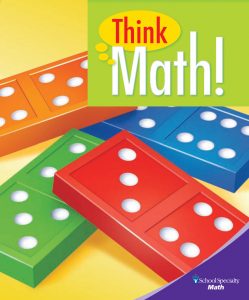Overview
 Think Math! is founded upon the principle that children are curious problem solvers. Each grade level’s content builds a puzzler’s disposition, developing mathematical “habits of mind” through games, puzzles, mental math, and other collaborative activities – with the goal of providing engaging and motivating experiences for a community of diverse learners.
Think Math! is founded upon the principle that children are curious problem solvers. Each grade level’s content builds a puzzler’s disposition, developing mathematical “habits of mind” through games, puzzles, mental math, and other collaborative activities – with the goal of providing engaging and motivating experiences for a community of diverse learners.
In Think Math!, kindergarteners spend significant time representing whole numbers, beginning with numbers to 10 and eventually numbers to 20, using objects, pictures, drawings, and sounds. They use numbers to describe quantity and order and make comparisons using words such as “more than,” “greater than,” “less than,” “same as,” and “equal to” and are eventually introduced to >, <, and = symbols. Children eventually explore representing addition and subtraction as jumps on a number line, understanding that a “plus” jump moves forwards and a “minus” jump moves backwards. They sort and compare two-dimensional and three-dimensional shapes and describe common attributes.
All student materials can be accessed through the table below as PDFs by chapter.
Chapter Listing
| Chapter | Topics | Think Math! Resources |
|---|---|---|
| Chapter 1: Numbers to Ten |
|
Chapter 1 Student Lesson Activity Book (LAB) pages Chapter 1 Activity Masters Chapter 1 Flip Chart |
| Chapter 2: Two-Dimensional Figures and Quantities |
|
Chapter 2 Student Lesson Activity Book (LAB) pages Chapter 2 Activity Masters Chapter 2 Flip Chart |
| Chapter 3: Patterns and Sorting |
|
Chapter 3 Student Lesson Activity Book (LAB) pages Chapter 3 Activity Masters Chapter 3 Flip Chart |
| Chapter 4: Moving on the Number Line |
|
Chapter 4 Student Lesson Activity Book (LAB) pages Chapter 4 Activity Masters Chapter 4 Flip Chart |
| Chapter 5: Making and Breaking Numbers |
|
Chapter 5 Student Lesson Activity Book (LAB) pages Chapter 5 Activity Masters Chapter 5 Flip Chart |
| Chapter 6: Stories in Numbers, Words, and Pictures |
|
Chapter 6 Student Lesson Activity Book (LAB) pages Chapter 6 Activity Masters Chapter 6 Flip Chart |
| Chapter 7: Three-Dimensional Geometry |
|
Chapter 7 Student Lesson Activity Book (LAB) pages Chapter 7 Activity Masters |
| Chapter 8: Measurement |
|
Chapter 8 Student Lesson Activity Book (LAB) pages Chapter 8 Activity Masters Chapter 8 Flip Chart |
| Chapter 9: Large Numbers |
|
Chapter 9 Student Lesson Activity Book (LAB) pages Chapter 9 Activity Masters Chapter 9 Flip Chart |
